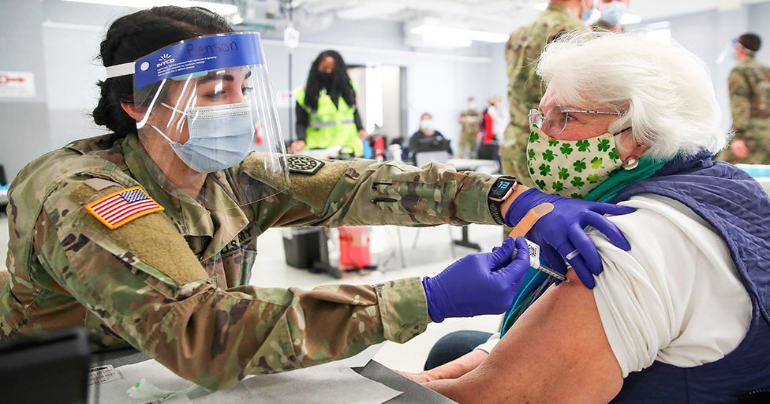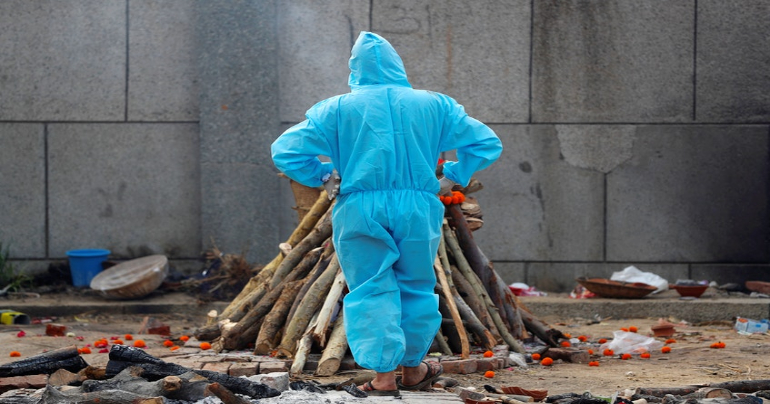It’s been a long winter for the US, with hospitals seeing more coronavirus patients than at any point in the pandemic and the average number of daily deaths topping 3,000 for the first time.
But as spring approaches, the number of infections is now falling and the vaccination programme looks to have overcome some of its initial problems.
So is the US on track to get back to some form of normality in 2021 or do new variants of the virus mean further setbacks are ahead?
We’ve taken a look at the data and spoken to an epidemiologist to assess the situation.
The winter surge has peaked
The average number of daily cases in the US had been rising since September – apart from a few dips due to incomplete data over holiday periods like Thanksgiving and Christmas.
But as you can see from the chart below, daily cases have now been falling since early January.
There are, however, still more than 130,000 new infections every day on average and it’s unclear whether the recent decline will continue – especially now the US has cases of the more highly transmissible variants of virus, first discovered in the UK, South Africa and Brazil.
Overall, there have been nearly 30 million confirmed cases in the US – the highest figure in the world. But as testing was so limited in spring last year, the true number is probably much higher.
One study by scientists at the US Centers for Disease Control and Prevention suggested the real number was as high as 100m towards the end of last year.
Hospitals are still under pressure
Although the decline in cases is good news, it will be a few weeks before it has any major effect on the number of coronavirus patients in hospitals across the US.
That number has been falling for a few weeks now, but nearly 90,000 people are currently in hospital – that’s 30,000 more than during the two previous surges last year.
The latest data compiled by the COVID Tracking Project shows the number of Covid patients in hospital is falling in all four regions of the US, with the Midwest having seen the biggest drop since the start of the year.
Deaths will be slow to fall
January was the deadliest month of the pandemic in the US, with 95,000 deaths reported – more than a fifth of the overall death toll of 455,000.
The average number of deaths remains extremely high at 3,000 a day at the moment, but there are now signs of a small decline in recent days.
However, deaths is a metric that lags behind cases and hospitalisations because it can take several weeks for those who are worst-hit to die from the disease.
So the US, which already has the highest coronavirus death toll in the world, is likely to pass 500,000 deaths later this month.
Vaccine rollout is looking positive
There were some initial problems with the rollout of vaccines in the US. The government set a target of vaccinating 20 million Americans by the end of 2020 but managed just three million.
However, things improved in January.
President Joe Biden set a goal of 100 million vaccinations administered by his 100th day in office – but they were already well on the way to that before he took office. An average of one million shots a day was hit on 21 January, the day after he was inaugurated.
The US is now averaging about 1.3 million vaccinations a day and Mr Biden has upped his target to 1.5 million a day.
The picture is still quite varied when you look at state-level data though. Alaska is currently top with 18 doses administered per 100 people, but in Missouri the figure is just nine.
It also appears that more needs to be done to ensure vaccines are getting to the most vulnerable groups.
Recent research by the Kaiser Family Foundation, a US healthcare charity, found that black people account for a smaller share of vaccinations compared to their share of cases and deaths in nearly all states reporting such data.
By global standards, however, the US programme is going well. The country’s average of 11 vaccinations administered per 100 people is above Canada (3) and all of Europe apart from the UK (17). Israel has the highest rate of any country, with 62 per 100 people.
Months to go before ‘new normal’
With the vaccine rollout picking up pace, many Americans will be hoping life can return to some form of normality over the next few months – but experts say there’s still a long path ahead.
“It will be many more months before we see not necessarily a return to normalcy, but the emergence of a new normal,” according to Dr Keri Althoff, a professor of epidemiology at Johns Hopkins University.
“I’m hesitant to put a date on it because every time we figure something out with this virus, it seems to have another trick up its sleeve,” she added, pointing to the new variants that have emerged in recent months.
Dr Althoff says that “new normal” will see public health officials continuing to recommend social distancing and face masks while warning against any large social gatherings, inside or out.
“Many people in the US are feeling exhausted by this virus. It’s totally normal and we need to be empathetic towards that, but this virus is not going to just go away,” she said.
“So we have to continue to protect ourselves and our families and our communities.”
SOURCE: BBC







Leave a Comment